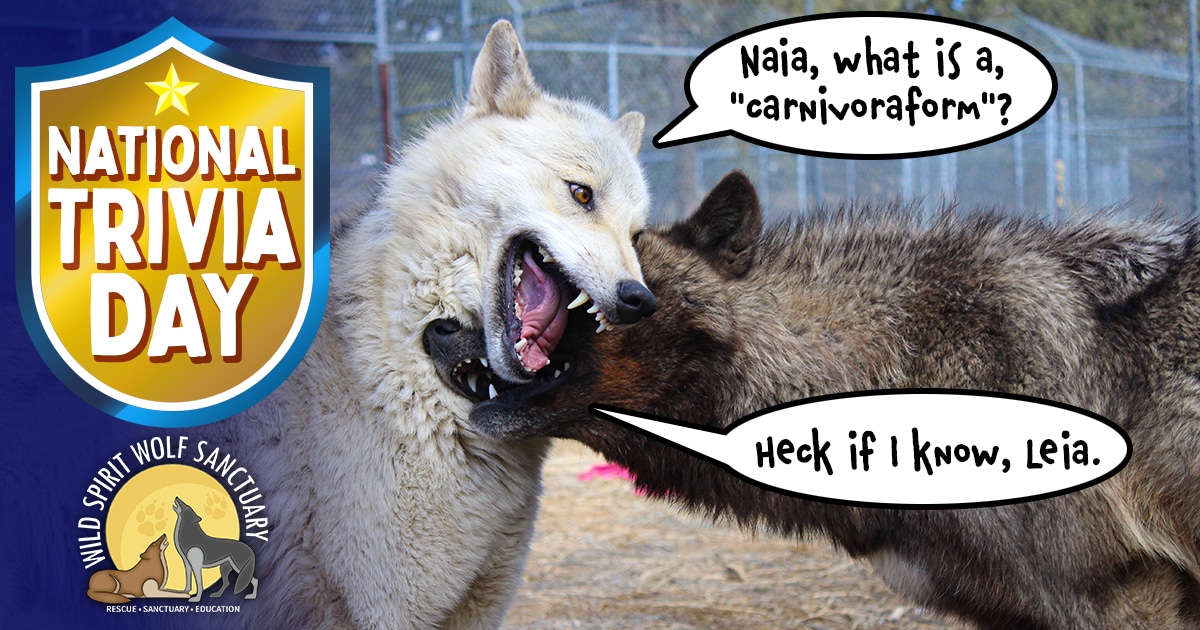
National Trivia Day
DID YOU KNOW? January 4th is designated as National Trivia Day! Founded in 1980 by Robert L. Birch of Pun Corps, it is a day to enjoy all things academically trivial—Binge that 80s classic Jeopardy!, dig out that dust-littered Trivial Pursuit and play a round with friends and family, or, if you’re an all-things-animals buff, read further.
To celebrate the traditionally competitive and addictive game of trivia, the team has generated its own researched Wild Spirit Trivia™ for our fang-tastic Howling Supporters to play!
It’s simple, just select one of the five categories below: History, Art, Science, Geography, or Entertainment where two questions are available in each for you to try to answer; then finish by clicking the Wild Spirit Trivia™ question to reveal that juicy fact! We hope you enjoy and perhaps even learn something new to expand your trivia repertoire.
QUESTION: What extinct species is currently closest to the origin of carnivoraforms, which includes canids (e.g., dogs) and felids (e.g., cats)?
Sources
“Dormaalocyon latouri: Prehistoric Mammal Sheds Light on Origins of Carnivoraforms.” Sci-News. Sci-News, 9 Jan. 2014, www.sci-news.com/paleontology/science-dormaalocyon-latouri-mammal-origins-carnivoraforms-01671.html. Accessed Nov. 2020.
Handwerk, Brian. “Ancient Arboreal Mammal Discovered at Root of Carnivore Family Tree.” National Geographic. National Geographic Society, 9 Jan. 2014, www.nationalgeographic.com/news/2014/1/140109-dormaalocyon-latouri-fossil-carnivore-science/. Accessed Nov. 2020.
QUESTION: How old is the current fossil record of the dingo in Australia?
Sources
Dalton, Angus. “Dingo bones excavated in 1960s are the oldest ever found.” Australian Geographic. Australian Geographic, 27 July 2018, www.australiangeographic.com.au/news/2018/07/dingo-bones-excavated-in-1960s-are-the-oldest-ever-found/. Accessed Nov. 2020.
Balme, Jane; Fallon, Stewart; O’Connor, Sue. “New dates on dingo bones from Madura Cave provide oldest firm evidence for arrival of the species in Australia.” Nature. Springer Nature Limited, 19 July 2018, www.nature.com/articles/s41598-018-28324-x. Accessed Nov. 2020.
QUESTION: How are wolves most commonly misrepresented in artwork?
QUESTION: Who was the artist who sculpted the famous bronze statue of Balto in the Central Park Zoo of New York City?
Sources
“Balto.” Central Park Conservancy. www.centralparknyc.org/locations/balto. Accessed Nov. 2020.
“Balto.” IMDb. www.imdb.com/title/tt0112453/. Accessed Nov. 2020.
“The Real Story of Amblin’s Balto.” American Kennel Club. American Kennel Club, 12 Aug. 2016, www.akc.org/expert-advice/lifestyle/balto/. Accessed Nov. 2020.
“Why is There a Monument to Balto in Central Park?” New-York Historical Society. www.nyhistory.org/community/balto-statue-central-park. Accessed Nov. 2020.
QUESTION: Approximately, how genetically close are wolves to humans?
Sources
Garret-Hatfield, Lori. “Animals That Share Human DNA Sequences.” Seattlepi. Hearst Newspapers, LLC, education.seattlepi.com/animals-share-human-dna-sequences-6693.html. Accessed Nov. 2020.
Kasprak, Alex. “Are Dogs Really 99.9% Wolf?” Snopes. Snopes Media Group Inc, 28 Oct. 2016, www.snopes.com/fact-check/dogs-99-percent-wolf. Accessed Nov. 2020.
Lennon, Annie. “How Wolves Evolved into Dogs.” Labroots. LabRoots, Inc, 25 July 2019, www.labroots.com/trending/genetics-and-genomics/15279/wolves-evolved-dogs. Accessed Nov. 2020.
Pickrell, John. “Dog DNA Study Yields Clues to Origins of Breeds.” National Geographic. National Geographic Society, 1 May 2004, www.nationalgeographic.com/animals/2004/05/dog-dna-study-yields-clues-to-origins-of-breeds. Accessed Nov. 2020.
QUESTION: How many subspecies of the grey wolf (Canis lupus) currently exist?
Sources
The Editors of Encyclopaedia Britannica. “Gray wolf.” Britannica. Encyclopaedia Britannica, Inc, 5 Nov. 2020, www.britannica.com/animal/gray-wolf. Accessed Nov. 2020.
“Types of Wolves.” International Wolf Center. International Wolf Center. www.wolf.org/wolf-info/basic-wolf-info/types-of-wolves. Accessed Nov. 2020.
QUESTION: What is the geographic range of the red wolf (Canis rufus)?
Sources
“Red Wolf.” The National Wildlife Federation. The National Wildlife Federation. www.nwf.org/Educational-Resources/Wildlife-Guide/Mammals/Red-Wolf#:~:text=Red%20wolves%20weigh%20anywhere%20between,eastern%20North%20Carolina%27s%20Albemarle%20Peninsula. Accessed Nov. 2020.
“Red wolves.” National Geographic. National Geographic Partners, LLC. www.nationalgeographic.com/animals/mammals/r/red-wolf. Accessed Nov. 2020.
QUESTION: Where can the red fox be found?
Sources
“Vulpes vulpes (red fox).” CABI. CAB International. www.cabi.org/isc/datasheet/59487. Accessed Nov. 2020.
“Red Fox.” National Geographic. National Geographic Partners, LLC. www.nationalgeographic.com/animals/mammals/r/red-fox. Accessed Nov. 2020.
QUESTION: What animal does Hollywood generally use to portray wolves?
QUESTION: What animal befriended a hound in the classic Disney movie released in 1981? Bonus: What was his name?
Sources
“The Fox and the Hound.” IMDb. www.imdb.com/title/tt0082406. Accessed Nov. 2020.
“The Fox and the Hound.” Wikipedia: The Free Encyclopedia. Wikipedia, 17 Dec. 2020, en.wikipedia.org/wiki/The_Fox_and_the_Hound. Accessed Nov. 2020.

0 Comments